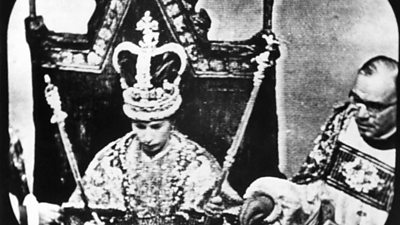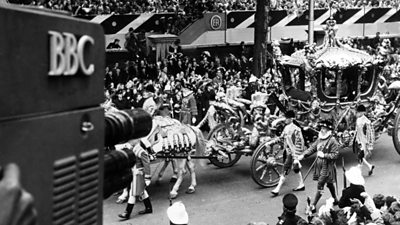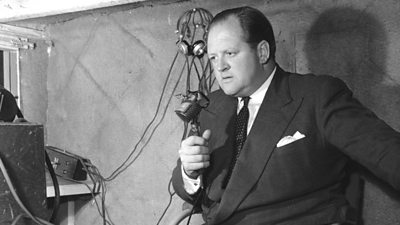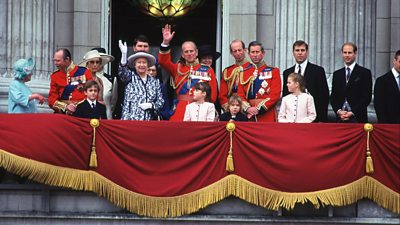In December 1949 a second transmitter station, at Sutton Coldfield near Birmingham, was opened.
At a stroke it offered the service to a further nine million people. Two years later Holme Moss, high in the Pennines , brought a further 11 million within range. Kirk O'Shotts, between Glasgow and Edinburgh, and Wenvoe in South Wales had added a further eight million by the summer of 1952, and although there were still many gaps in coverage, BBC Television was at last a national service.
Thus the stage was set for the event that did more than anything else to elevate television from 'Cinderella' service to a mainstream medium. The BBC knew, from the experience of the 1937 Coronation, that the crowning of Queen Elizabeth II on 2 June 1953 would be the most demanding television outside broadcast in its brief history, but it had little sense of how important a watershed this would be for television itself.
Planning began immediately after King George VI died (on 6 February 1952), and over the following months the sale of television sets rose in anticipation of the big day. The BBC had acquired 100 redundant military transmitters at the end of the war, and BBC engineers went to work converting them for sound and picture transmissions for the north east of England and Northern Ireland - which would otherwise be without coverage.
The newspapers took great interest in the broadcast arrangements, and speculated on whether or not the cameras, which had been excluded from the King's funeral at Windsor 15 months earlier, would again be barred from royal ceremony. It was the Queen herself who settled the debate, giving the new medium an unprecedented seal of approval.

The BBC's preparations had been led at the outset by sound, but it was undoubtedly television's moment. For the first time viewers outnumbered listeners (by as much as three to one in some areas). Some 7.8 million people watched in their own homes, and 10.4 million watched in other people's homes. A further 1.5 million watched in cinemas, halls and pubs.
It was also an occasion that demonstrated the global appeal of British pageantry as never before. Tele-recordings of the BBC's coverage were flown to the United States, where 85 million watched. German television relayed all 11 hours of the BBC's coverage, and a million people in France picked up the BBC pictures.
That year, again for the first time, the manufacture of television sets in the UK outstripped radio production. From 1949 to 1951 the number of sound and television licences had risen from 126,000 to 763,000. Thanks largely to the Coronation, take-up accelerated sharply to 3.2 million homes by 1954.
Moreover, television now enjoyed political as well as popular support, the Beveridge Report having paved the way for the launch of ITV in 1955. By now, the BBC had expanded into former film studios at Lime Grove, near Shepherd's Bush, and plans were being drawn up to develop the world’s first purpose-built studios in Wood Lane, West London. Television was here to stay.
Further reading
-

Television's Crowning Moment
From the Story of BBC Television -

Two Coronations
Dr Alban Webb explores the evolution of television between the 1936 coronation of King George VI and the 1953 coronation of Queen Elizabeth II. -

The Coronation and the BBC
Matt Verrill reviews two BBC publications about the corporation's coverage of the Coronation in 1953. -

A timeline of Queen Elizabeth II
A timeline of Queen Elizabeth II, Britain’s longest reigning monarch, from BBC Teach




